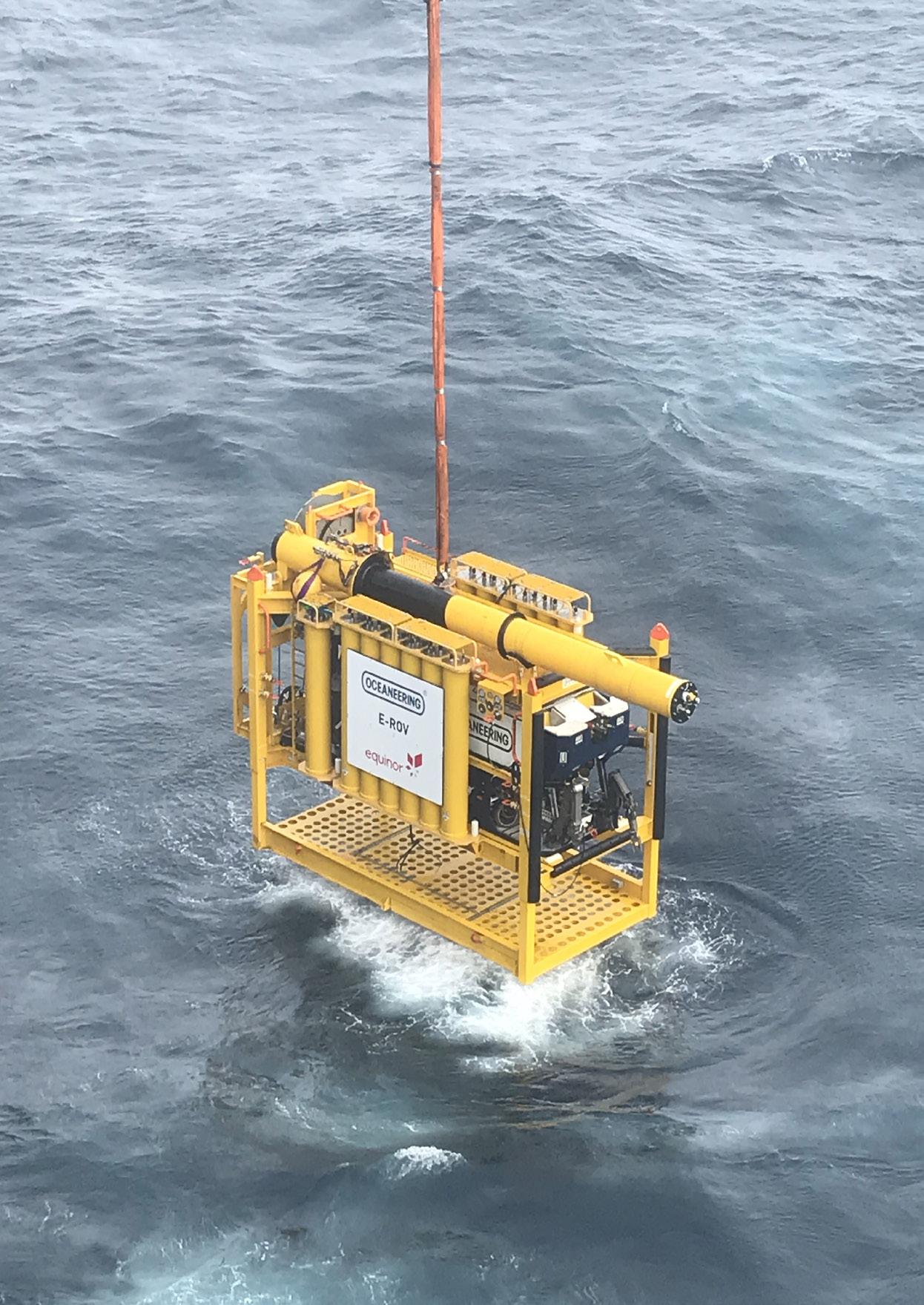
32 minute read
UT THREE U N D E R W A T E R TECHNOLOGY
from UT3 Issue 1 2020
by UT-2.com
Ocean Infinity has announced the launch of the marine technology and data company, Armada.
The pioneering AUV operator had previously built its operation on controlling multiple AUVs from a
Advertisement
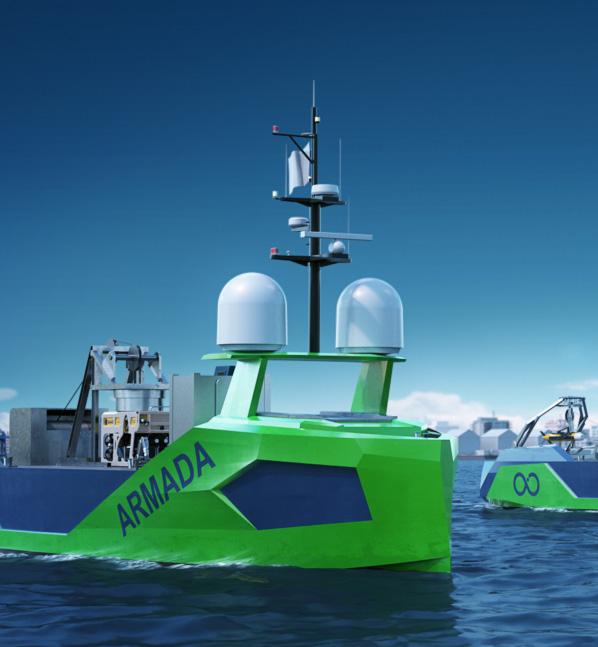
single mother vessel to survey the ocean seabed. The new company will broadly seek to emulate this by controlling multiple autonomous surface vehicles from a single location.
The company will use up to fifteen bespoke-designed unmanned surface vessels to perform a multiplicity of offshore data acquisition and intervention operations. These robot ships will be capable of remotely deploying a wide range of the latest sensors as well as AUVs and ROVs for
ARMADA LAUNCHED

visual and acoustic data acquisition.
Armada’s fleet requires neither people on board nor a host vessel nearby. Instead they will be controlled and operated by experienced mariners via satellite communications from state of the art onshore facilities in both Austin (Texas) and Southampton (England).
With zero people required at sea Armada operations are set to be the safest the industry has seen. The fleet approach produces up to 90% less CO2 than other conventional survey vessels, also making it the most environmentally sustainable company in the industry. Armada’s fleet is currently under construction and is expected to be deployable by the end of 2020.
NEWS
Valhall Flank West
l Aker BP and Pandion Energy has announced first oil was from Valhall Flank West in the North Sea.
Valhall Flank West is a wellhead platform that will normally be unmanned. It receives power from shore via the Valhall field centre.
The platform has been delivered with the world’s first electric lifeboat monitored from the Valhall field centre. Both the crane and seawater pump are electric and receive power from the field centre. All of this contributes to reduce maintenance.
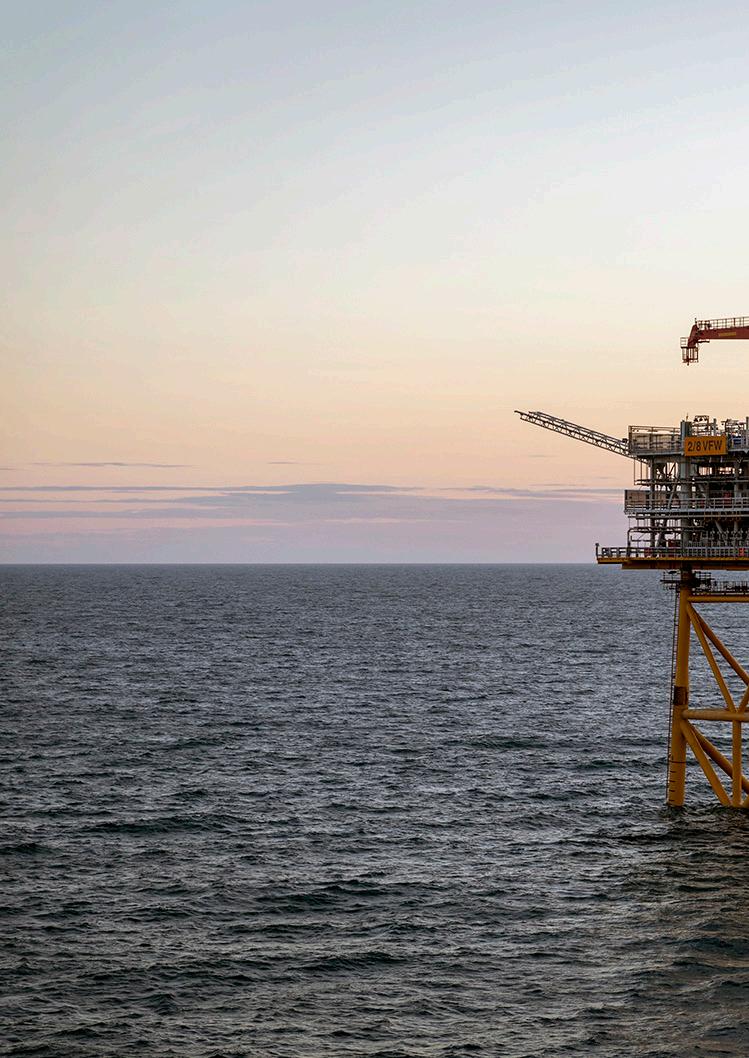
Alliances have contributed to the project in addition to the wellhead platform alliance. These are Subsea alliance between Aker BP, Subsea 7 and Aker Solutions, the Modification alliance between Aker BP and Aker Solutions and the Alliance for jack-up rigs between Aker BP, Maersk Drilling and Halliburton.
Valhall Flank West
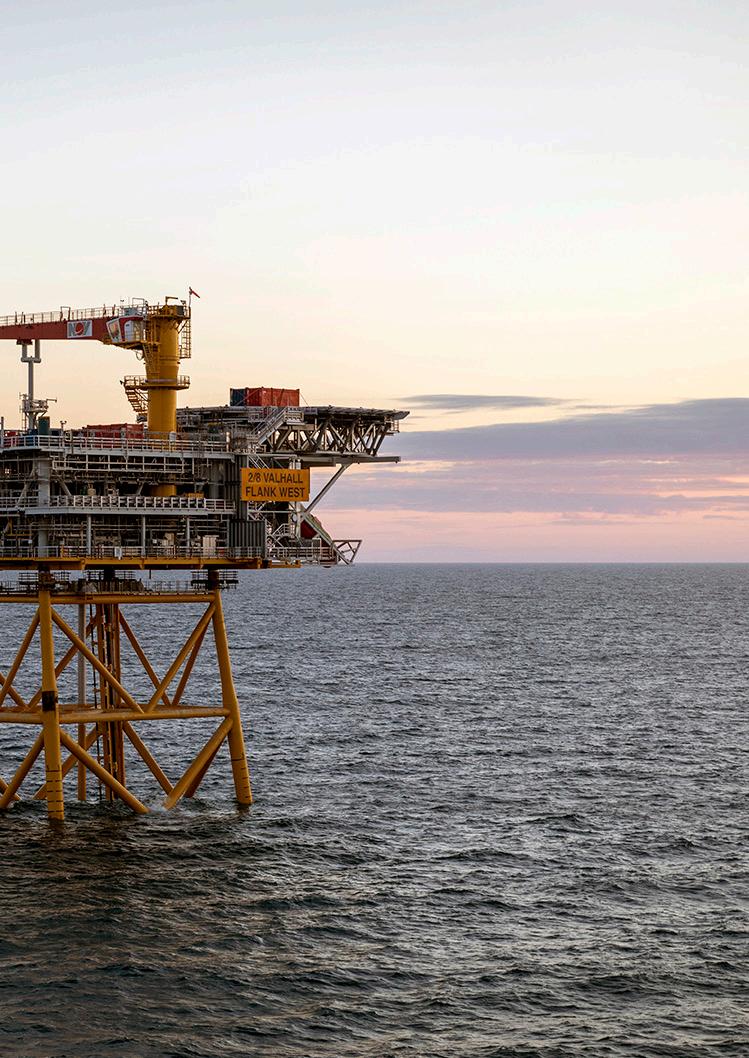
HYDROID NEWS SOLD
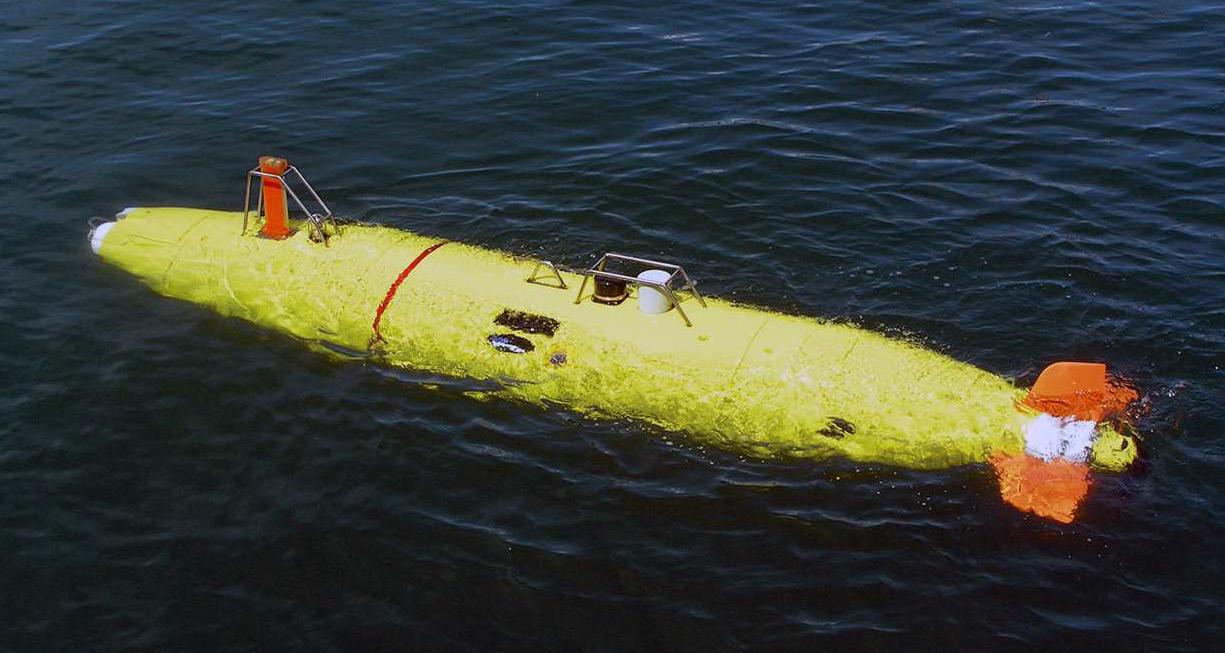
Kongsberg Maritime AS has signed an agreement to sell its underwater technology company Hydroid for US$ 350 million to Huntington Ingalls Industries (HII), the largest supplier of vessels to the US Navy.
The agreement provides that, as of closing, the parties will enter into a strategic alliance agreement concerning underwater technology and maritime solutions.
Kongsberg Maritime acquired Hydroid for US$ 80 million in 2007 and is now selling this US subsidiary for USD US$ million on a debt-free and cash-free basis and as adjusted off an agreed upon working capital.
"Kongsberg Maritime has driven technology development and created considerable value during the 12 years it has owned Hydroid, and we are capitalizing on this now. We are proud to have positioned Hydroid as a leading supplier of small and mediumsized autonomous underwater vessels in the market.
We now look forward to work together with HII on new, maritime solutions and, at the same time, strengthening our world-leading underwater
environment in Horten,” says Geir Håøy, President and CEO of the KONGSBERG Group.
“Kongsberg Maritime will continue to aggressively develop technology, including that related to our underwater expertise. We are the global leader in civilian-sector maritime technology, while HII is the world's largest supplier of navy vessels. This alliance will allow a wider range of our maritime solutions for both naval and civilian usage in the United States and the rest of the world,” says Egil Haugsdal, President of Kongsberg Maritime.
5D & 6D SONAR
By Dr. Angus McFadzean Dr. Charlie Pearson
The Echoscope was the world’s first sonar system that allowed moving objects in the water column to be viewed in real time, making it the first truly four-dimensional sonar. The Echoscope’s video quality imaging has continued to lead the field for over two decades.
Coda Octopus are now achieving another world first – bringing to the market the world’s first 5D and 6D Sonars.
The original Echoscope system, first released in 2004, revolutionised sonar by simultaneously beamforming a grid of over 16 000 beams, allowing a full depth image to be generated in under 1/10th of a second.
This rapid processing allowed the system to deliver the Echoscope’s trademark real-time output, generating video quality, views of moving objects in the water column.
The ability to present these maps in real time means that the existing Echoscope is already a 4D system, and it is this fourth dimension that continues to differentiate the Echoscope from its competitors.
Coda Octopus have continued to push the technological boundaries, and are releasing a series of new 5D and 6D sonars that are set to dramatically extend the capability of the Echoscope.
At the heart of this new system is a state-of-the art processor that allows the sonar data to be handled orders of magnitude faster, and with much greater flexibility, or stored for off-line processing. The biggest change facilitated by this processor is the ability to beamform the entire duration of each sonar ping to give full time series data on all beams.
Rather than just returning a single range image with a maximum 16,384 points (one point for each of 128x128 beams), the new system returns a fully populated volume of over 1.6 million beamformed data points, while still operating at over 20 pings per second!
The ability to return multiple data points on every beam takes the data from 4D to 5D and presents a wealth of new opportunities for analysing the sonar data.
The biggest initial advantage is that the 5D system generates much fuller, and more detailed images when the points are rendered in , as the beamformer can potentially see around smaller objects in the near-field.
The system also returns multiple range points for beams striking flat surfaces at high incidence angles, meaning that the seafloor is much better resolved in the far field of the volume image.
The state-of-the-art processor has also allowed the sensitivity of the beamformer to be increased, as its floating-point operation allows for a much greater dynamic range in the data.
This is a significant advantage in many acoustically challenging applications and environments. The combination of having multiple range points on each beam and the increase in sensitivity means that the far-field can be much more clearly and densely resolved in the output images. datasets takes the new system to its sixth data dimension (6D).
The development of PIPE is not just restricted to the data processing side of the system, with hardware updates also being implemented to maximise the functionality of this new tool.
Different 5D data outputs might require different signals to be transmitted from the sonar, or might need different signal amplification and filtering operations to be applied. For example, one task might need high-resolution and a narrow field of view, while another could require a low-frequency, long range signal with a wide field of view. PIPE allows these different 5D datasets to be processed concurrently by switching between many different sets of sonar operating parameters, with this switching occurring from ping to ping at 20Hz. It is possible, for example, to generate four completely different 5D sonar images separated by less than 0.05 sec, with the composite, 6D image being fully updated 5 times per second.
To understand the full potential of this new technology, consider a pipe inspection operation being conducted with an ROV. The ROV pilot requires a longer range, forward looking view to allow both navigation and obstacle avoidance.
The major increase in the quality and volume of data generated by the 5D system means that new types of data processing are possible, and new, useful information can be extracted. The challenge with large datasets, however, is that they can be slow and cumbersome to analyse. To combat this Coda Octopus have developed PIPE:
The Parallel Information Processing Engine. This tool adopts novel parallel processing methods to perform multiple, simultaneous analyses of the large 5D dataset, delivering a range of useful outputs in real time. This ability to produce multiple, concurrent 5D There could then be an engineer inspecting the condition of the pipe itself, who requires a high resolution, downward looking image to be able to detect damage or corrosion on the pipe.
The 6D PIPE system is capable of generating both these images simultaneously in real time, meaning that the engineers are able to make instant decisions, such as whether to slow down to inspect a particular section of pipe in more detail.
Since the raw data from the survey is also being stored, it is possible
to go back through the data in postprocessing and apply different image processing methods to highlight different information.
While this does not provide quite the same flexibility as the real-time 6D processing - since the transmit and receive parameters are fixed - there is still significant value in having access to the measured raw data rather than a processed image that has already removed a large proportion of the original information.
In the case study presented above, all the different presentations of the data were being viewed by human analysts, but this doesn’t have to be the case: the new 5D/6D data makes the latest generation Echoscope very well suited to deployment on a fully autonomous vehicle.
As an example, the system could be
Echoscope image
operated to simultaneously provide a far-field obstacle avoidance view, and a high-resolution seabed view for detailed autonomous navigation. The raw data could then be stored for subsequent human post-processing and analysis once the AUV is returned to the surface.
The Echoscope 5D/6D system is the sonar for the information age. It uses the very latest hardware and software to open up a range of new possibilities for visualising and analysing the underwater environment.
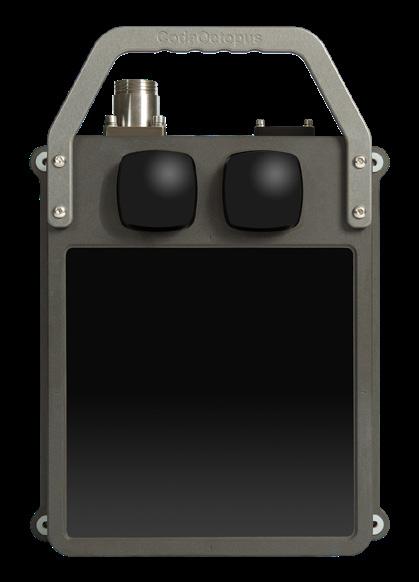
The 5D/6D system is also ideally placed to satisfy the future needs of the growing fleet of autonomous vessels in the world’s oceans, lakes and rivers. It therefore looks likely that the new generation of Coda Octopus 5D/6D Echoscopes will continue to lead the field, as their 4D predecessors have done before them.
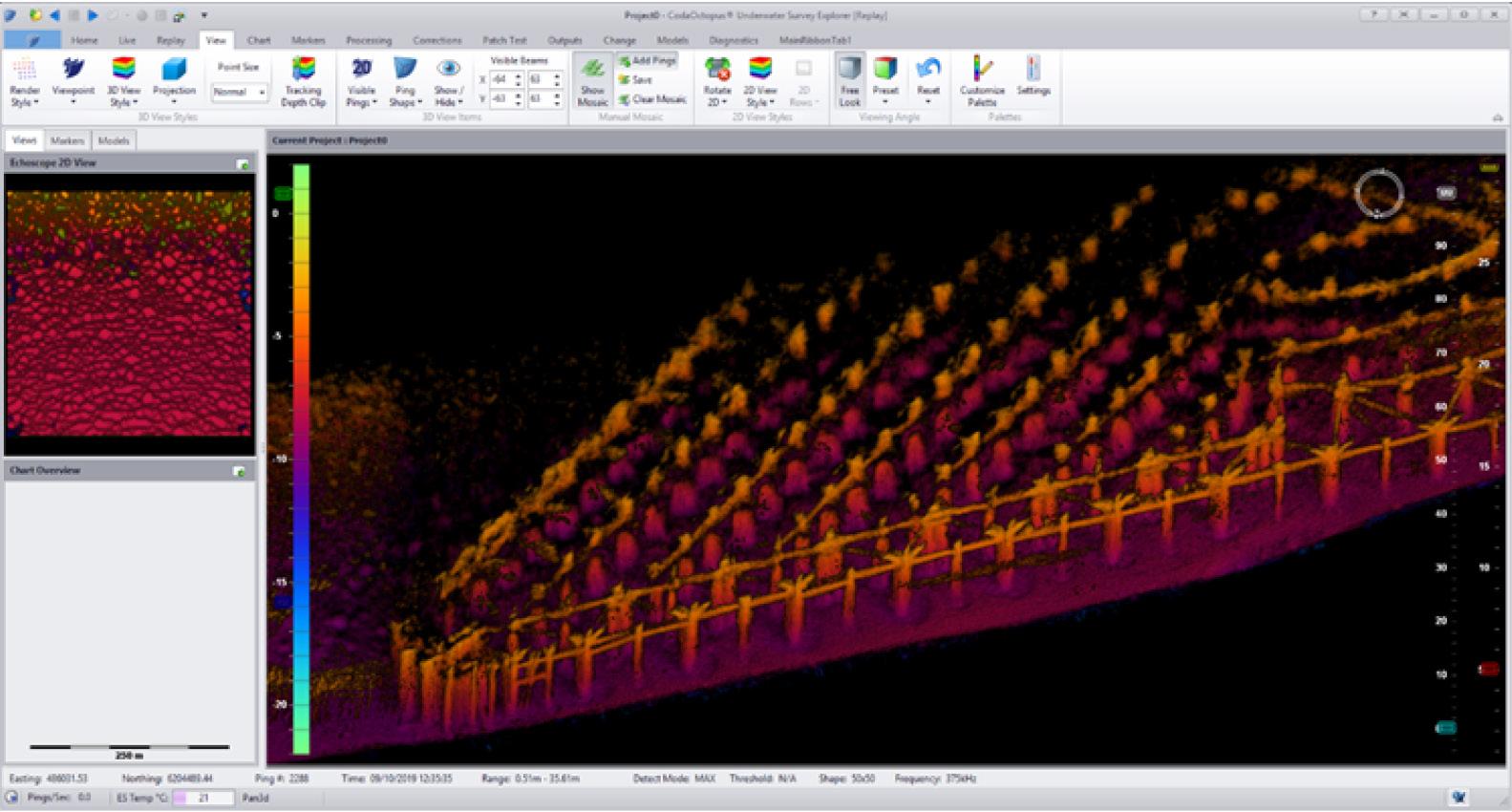
LEAK DETECTION
The convoluted pathway of oil and gas, from subsea wellhead through to market, invariably involves its passage through a network of subsea pipes of varying sizes and dimensions.
While all lines strongly adhere to stringent design guidelines and are engineered not to leak, they may become subject to external conditions that could put the pipe under unforeseen stress.
This might, for example, include unplanned deburial, unconstrained thermal expansion or being subject to a catastrophic event such as a dropped object rupturing the pipe or a trawlboard snagging a subsea structure. Seabed instability may result in the pipe being unsupported, bent and put under fatigue, possibly leading to critical fracture or buckling.
As production techniques have become more efficient, existing subsea infrastructure has been asked to work beyond its original design life. Ageing equipment means more areas of potential leakage.
Statistics show that critical components such as connectors, flanges, seals and welds on valves and small-bore wellhead and template piping, are all common sources of leaks. Gradual leaks may also occur through microcracks caused by corrosion and wall thinning. These are far more difficult to recognise but can potentially represent a significant longer-term problem and demand enhanced inspection programmes.
Any early warning of small leaks can allow operators to take remedial actions, potentially saving money and reputation.
Monitoring is particularly important as the industry looks to work in new unexplored frontiers and depths, in a market increasingly sensitive to environmental issues and intolerant of introducing polluting materials into the marine environment. Most subsea equipment such as valve manifolds, control modules and blow out preventers are actuated using hydraulic fluid delivered in tubes.
Because of tightening legislation, these hydraulic fluids are now often waterbased and more environmentally friendly, however, leakage within the system can result in falling internal circuit pressures, causing the equipment to shut down by failing safe. Once shut down, the system may be difficult to re-energise.
To detect leaks, the subsea industry has developed a wide range of complementary subsea detection systems. One such is by monitoring the parameters of the internal product.
INTERNAL DETECTION Internal leak detection systems are based on installing sensors inside the pipe, particularly at interface locations. These look for changes in temperature, pressure, viscosity, flow rate, density and sonic velocity etc. This information is then fed into the development’s supervisory control and data acquisition (SCADA) computers that form part of the field management system.
Unfortunately, during normal pipeline operations, variations in pressure and other key parameters occur every time the line is started, production moves into different flow regimes, part of the system is shut-in or even if a valve
CONTD PAGR 30
Sonardyne's Sentry leak detector

through the layer the conductivity is converted to a voltage signal.
Sniffers can detect very small concentrations of dissolved gas in water. Its sensitivity is dependent on the distance to the leak and the drift of the leaking medium. One such device is the Sniffit, developed by Neptune Oceanographics and distributed through Seatronics. This was developed specifically to allow, real time in situ detection and has been successful in hydrocarbon surveys to depths of over 3000m world-wide.
The sensor can be used as a quick pass for general ‘look and see’ surveys or used in detail mode to detect the exact location of a subsea leak. The Sniffit is easily mounted on a ROV, AUV, towed vehicle, manned submarine, cable profiler or can be diver held.
BIOLOGICAL
By measuring their response to ambient pollution, it is possible to use biological organisms as point sensors. The blue mussel, for example, siphons 60 litres/day of water, but the valves (shells) have been shown to close up in varying degrees when exposed to harmful polyaromatic substances. It is also possible to detect changes in the heart rhythm.
One leak detection guide, therefore, involves placing a number of blue mussels on a tray and connecting them with sensors. This tray is then lowered into the water column. Shell movement is registered by electronic instrumentation.
Different biological species may be required for different water depths or salinities.
There are two basic parts to this sensor - the biological component and the transducer that converts any physical movement into an electrical signal.
Researchers at Mississippi State University have been looking into using Exoelectrogenic bacteria based that survive on organic matter. These are placed on one anode of a piece of apparatus, while autotrophic, or sulphur reducing are placed on a cathode. This allows a continuous
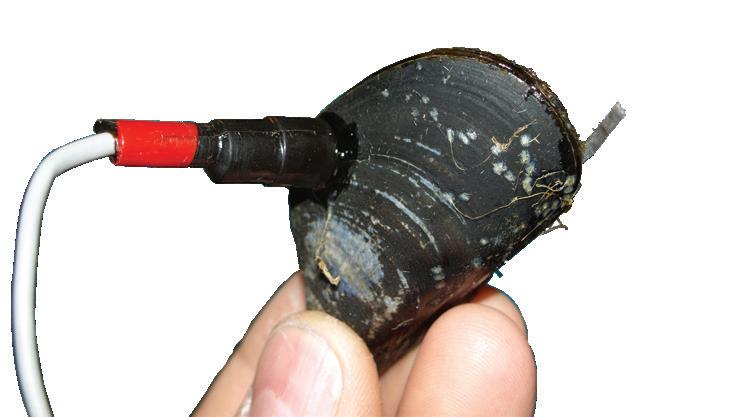
A blue mussel
SENTRY
Sonardyne has developed the Sentry IMS (Integrity Monitoring Sonar) point system, capable of monitoring more than one billion cubic feet of seawater, with 360° of coverage. A dual-phase oil leak of 0.1 b/d would detectable at ranges in excess of 500m.
Sentry works by sending a short-duration, highbandwidth ultrasonic pulse into the water and listens for echoes. Internal software is capable of discriminating between hydrocarbon leaks and targets such as underwater vehicles.
When such a leak is detected, data regarding the leak characteristics and position are shown on a display and can also be exported to other monitoring or control systems via an Ethernet link.
Sentry does not need to be within visual range as would be the case for video inspection using an ROV. It can detect low differential pressure leaks that are silent and which can’t be picked up with passive hydrophones. The sonar has a user-configurable detection radius of up to 1500m (5000ft).
Recently, a major US oil company deployed Sentry onto the seafloor in more than 2000m (6500ft) water depths under a sixmonth trial to demonstrate its ability to provide real-time subsea asset monitoring. The Sentry sonar head was mounted on a seafloor lander and as part of the trial a simulated, an oil plume in the water was detected within seconds of the simulated leak occurring.
Sentry’s capability covers 100 barrels/day mono-phase oil leaks at distances of up to 740m (2427ft). For mono-phase gas leaks, the system is capable of detecting down to just 1 b/d at 500m (1640 ft) or 100 b/d at 1000m (3280 ft).
A recent battery-powered unit was deployed by major international and independent operators in the US Gulf of Mexico and offshore Papua New Guinea. It has also been used in the UK to detect carbon dioxide leaks from the seafloor as part of an offshore carbon capture and storage (CCS) demonstration project. Uniquely, its Titanium housing and ROV-deployable design also makes Sentry useful for deepwater asset integrity monitoring.
transfer of electrons, creating a voltage across a cell.
When organic compounds pass between, the biosensor cell will generate high voltage spikes. It potentially allows the detection of very small leaks at an early stage. TEMPERATURE
When hot oil escapes into the surrounding seawater, it may locally raise the temperature. Escaping gas, however, causes a cooling due to the Joule Thomson effect.
These can be detected by fast high-precision thermistors. Neptune Oceanographics has developed a differential temperature technique that can detect very small changes
The Sentry
ACOUSTICS
Acoustic leak detection (ALD) is based on highly sensitive sonar technology. There are two different types – passive systems that listen for external sounds, and active systems that emit a pulse and listen for the echo.
PASSIVE Fluids leaking under pressure may emit high frequency noises at 30Hz – 120Hz. Provided the acoustic pressure waves propagating through the water are strong enough, ultrasound at frequencies can be picked up by hydrophones.
This means that the technique may not be suitable to detect small leaks per sae, although detection can be improved by directional hydrophones if these small leaks are 3bar or above. The sound may also be potentially masked by background noise such as that made from the thrusters or manipulators of ROVs working in the area (although these sounds can be blocked out by a high-pass filter). By mounting the sensor at the front of the ROV facing forward, mechanical noise is lost due to the sensor's directionality
Passive acoustics are very suitable for use as a point sensor. The higher number of sensors, the greater the spatial coverage while by measuring the precise time that the sound arrives at each sensor, it also may be possible to triangulate its origin.
ACTIVE Active systems emit their own sound pulse. As this propagates through the water, it may collide with a bubble of gas or oil droplet, causing the sound to be reflected back. As such, the technique may potentially give a large coverage area while being largely unaffected by turbidity.
This technology may also be unaffected by the chemistry of the leaking medium as long as there is an acoustic impedance contrast compared with water. Oil droplets give a strong backscatter while gas has very high acoustic impedance.
As the gas bubble size changes with water depth, detection performance can be variable, but systems can be generally accurate enough to detect gas leaks of 1boe/d at a range of 500m and live oil leaks of 10b/d at the same range.
When sonar systems are installed on vehicles, they can be used for wide area leak detection, such as over large reservoirs or along pipeline corridors. One such application was recently carried out using Sonardyne's Solstice Multi-Aperture Sonar (MAS).
This covers a 200 m wide swath with 0.15° along-track resolution, using just 18W. This low power consumption, wide swath and high data quality makes it suitable for use on low power, long-endurance Autonomous Underwater Vehicles (AUV), where Area Coverage Rate (ACR) and low false detection rates are key.
Solstice uses a back-projection beamforming technique to focus at every single pixel in the image, as well as using knowledge of platform motion and real-time array calibration to produce undistorted geo-stabilised imagery. Such high fidelity data enables the use of carefully designed and tested onboard Computer Aided Detection and Classification (CAD/CAC) and Automatic Target Recognition
Solstice has also been used to detect CO 2 leaks and simulated oil leaks, using environmentally friendly detection analogues. A test target emitting 15 litres a minute was placed on the seafloor for a trial project in the North Sea. METAS METAS has developed a Wide Area Active Monitoring (WAAM) acoustic monitoring system. It is designed for subsea installation, detecting even small amounts of oil and gas in ranges up to 1000m.

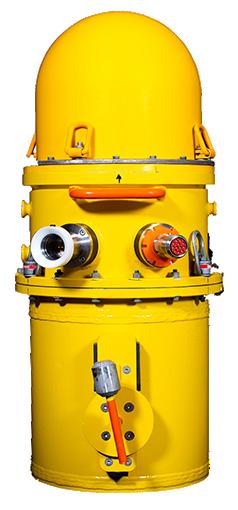
Metas WAAM system installed on Equinor’s Troll B field with acoustic map overlaying field layout
Various alternative hardware applications and sensors are available with horizontal scanning selectable from 0 to 360deg and 0deg–90 deg vertical for monitoring, or 3.14 km 2 of the subsea field.
Detected leaks can be analysed using in-house developed software which incorporates machine learning. This allows tracking of all acoustic responses, classification and analysis to determine if an alarm should be reported or merely an interesting data point recorded for future analysis.
If leakage is identified, the system will alarm and begin reporting approximate leakage rates including location of leak, plume size, distribution and direction of travel.
METAS has also developed the Near Area Active Leakage (NAAL) System is used to monitor know areas of leakage in high resolution. The system uses multiple acoustic transducers to accurately measure the leakage rate, frequency and distribution for any change which could indicate an increasing risk of loss of containment.
NEPTUNE OCEANOGRAPHICS Small leaks generate sounds at frequencies well above the audible range and requiring sophisticated sensors and software to reliably determine the difference between leak generated and ambient ‘noise’. One issue with this method is the sounds caused by the attendant (ROV) and other vessels in the vicinity can mask the sound.
GULF PIPELINE INSPECTION THE CCC SOLUTION
CCC Underwater Engineering is preparing to resume the second phase of a 2000km pipeline survey in the Arabian Gulf, totalling 316 pipelines.
They are inspecting the final 102 pipelines using their Saab Seaeye Leopard underwater robot, which CCC says is the best vehicle for the task.
Their objective is to achieve the most precise repeatable survey data possible, to a baseline accuracy below 0.5m.
This kind of accuracy, whilst working in extremely shallow water along different sized pipelines for extended periods, requires a large array of high definition filming and sensing equipment.
Abu Dhabi-based CCC Manager, Tavis Letherby, says that position repeatability accuracy is essential to secure a solid baseline for future surveys.
The necessary array aboard the Leopard includes three HD cameras with movie quality 1080i interlacing, two Kongsberg M3 profiling sonars, Sonardyne MiniRanger and SPRINT-Nav 500 Hybrid INS, Valeport bathy suite including altimeter, Valeport mini sound velocity profiler, MCS’s photorealistic cloud system, laser line generator, CP and UT probes.
“For accurate data acquisition,” says Tavis Letherby, “only a Leopard has the manoeuvrability, control and payload to stay steady and on course without problems in shallow water when faced with strong cross currents and wave motion - sometimes working in less than six metres of depth.”
He points to the vehicle’s specification of 11 thrusters, 500kgf of forward thrust, 200kg Saab Seaeye's Leopard ROV
payload and iCON intelligent control architecture, as making it suitable for very shallow water working whilst fully loaded with equipment.
When long excursions are necessary the operating vessel must stay around 70 metres clear of platforms for safety reasons. On those occasions the Leopard needs to navigate for up

to 100 metres to fulfil the pipeline inspection, which is a particular challenge in shallow water.
For Tavis Letherby the Leopard has advanced underwater robotics further into the digital world and offers operators a work vehicle costing half that of an equivalent hydraulic system.

Back in January 2017, Oceaneering was awarded a contract by the then Statoil, for the development, manufacturing, testing and mobilisation of a self-contained, battery-powered work-class remotely operated vehicle (E-ROV) system to be deployed on the seabed
THREE YEARS LATER........
FOR many years, the offshore service sector has been actively looking for ways to drive down costs. One key target has been deepwater operations involving underwater vehicles.
The cost of surface support vessels represents an uncomfortably high proportion of any ROV operation, and companies reasoned that a good way of reducing this expenditure would be to remove the vessel entirely. In practical terms, this would mean physically relocating the vehicle onto the seabed and providing basic fundamental support such as vehicle piloting and securing a suitable power supply, from elsewhere.
It is only in the last few years, however, that postdownturn confidence has grown enough for
companies such as Equinor to make the large financial commitments necessary to bring the seabed-resident vehicle concept into reality.
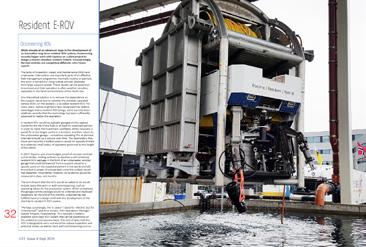
The basic ROV garage in 2018 as shown in UT2, Issue 4
It has challenged ROV manufacturers to develop the necessary technologies and inhouse processes necessary to accomplish this operational independence and backed this up with formal contracts.
Oceaneering had already begun its own journey down this path by developing on remote piloting systems. Seabedbased operations, however, would require a radically new reappraisal.
"The first step in providing a seabed resident solution, was to determine exactly what the market demanded," said Arve Iversen ROV Operations Manager, Special Projects. "We recognised two main applications.
"The first was for the use of a vehicle to carry out operations on a project-by-project basis, typically inspection and intervention tasks. It would reside subsea for relatively short durations of typically 1-8 weeks.
The other application was very different and looked at the need to carry out considerably longer term infield monitoring and inspection duties in which a facility would be resident subsea for nearer six months at a time.
"Ideally, these two radically different applications actually required two different vehicles.
"The principal requirement for any subsea-resident system is very high reliability. Statistically, this favours an electric ROV," said Iversen. "We already have our flagship eNovus
Docking funnel
Constant tension winch Buoy incorporating the comms antenna
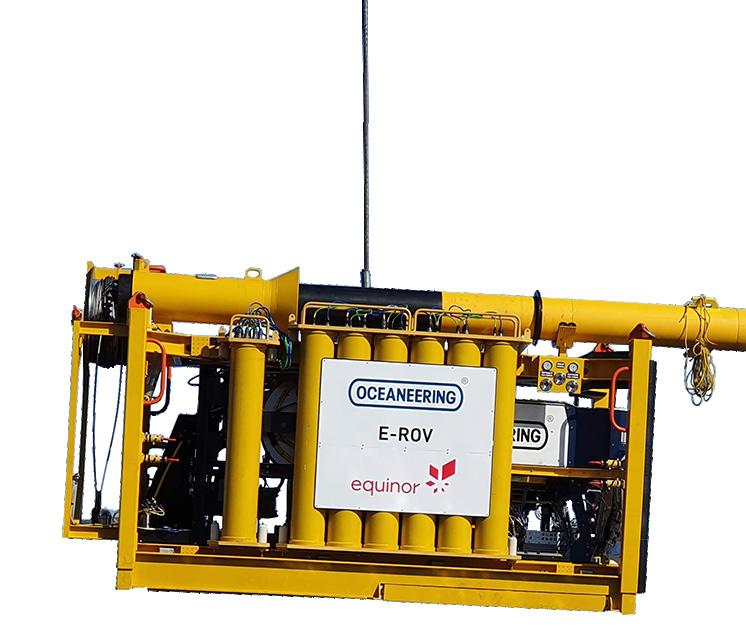
Mudmat control panel
48 Battery pods, 12 in total eNovus electric ROV
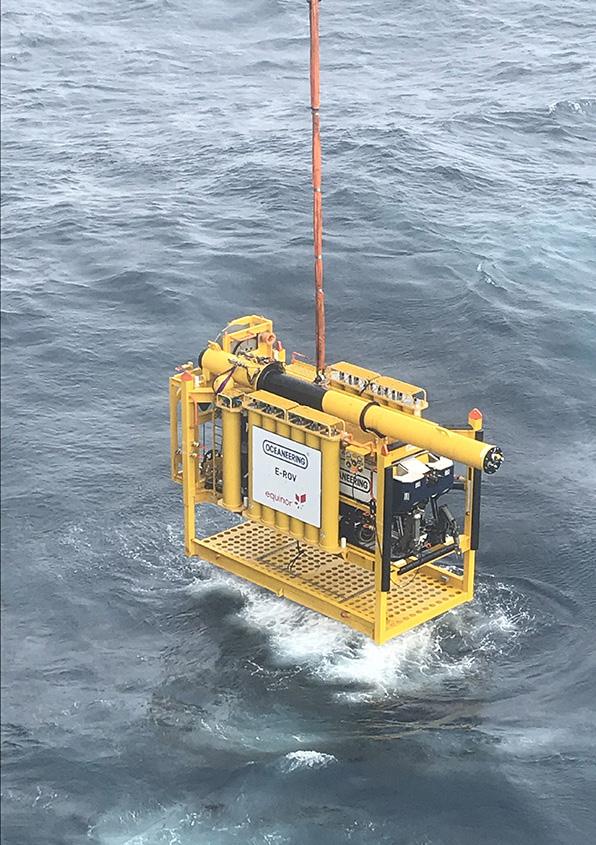

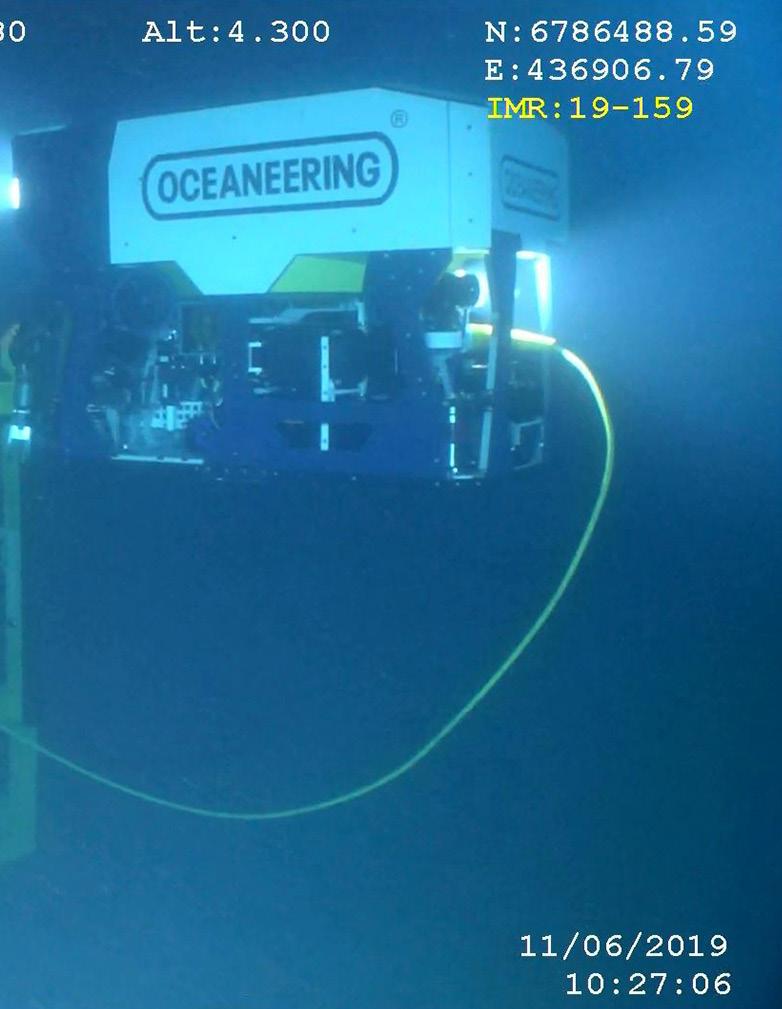
eLARS UNDERWATER INTERVENTION
MacArtney is planning to launch an all-electric, cost-efficient, launch and recovery system (LARS) for the ocean space market. This is a response to the demand for eco-friendly business strategies and product development.
The eLARS can be delivered as a complete system or as a stand-alone A-frame and will support a wide range of inspection/observation class, and work class ROVs. The eLARS is centred around a fully scalable platform that can be tailored to any customer specification.
The eLARS eco-friendly features include zero pressurised oil over water, significantly reducing the risk of harmful oil spillages and improved power efficiency that is considerably higher than that of traditional hydraulic systems. It requires less vessel power and improves overall energy efficiency, enabling vessels with smaller generator sets to operate the system. Going electric also increases usable deck space in the absence of the traditional HPU (Hydraulic Power Unit).
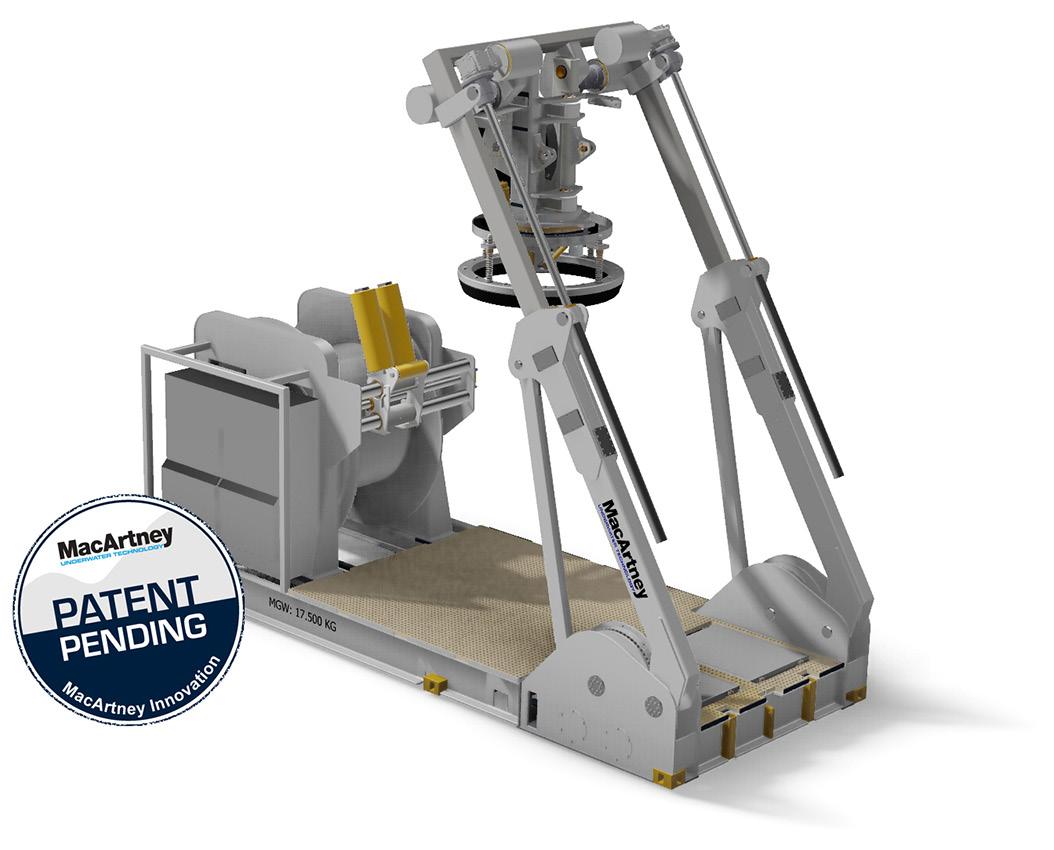
Following market trends, a zeroenergy eLARS is available for delivery, equipped with an energy harvest and battery system, significantly reducing the need for external power during operation and in some cases eliminating it entirely. The new eLARS provides an intelligent and highly versatile control system. A range of real-time condition metrics displays vital information that empowers the operator to make operational and maintenance decisions in the moment.
The high degree of built-in redundancy and the Emergency Recovery Mode provide a new-to-the-industry level of confidence even in extreme operational conditions. Full automation capability is also considerably easier with a control system design equipped for semi and fully automated operational sequences.
Additionally, the control system can be upgraded to virtually any new function, offering versatility and longevity.
A2KUI
Later this year, the newly -designed A2KUI will commence sea trials. A contraction of the official name Autosub 2K Under Ice, this is the new autonomous underwater vehicle (AUV) that will spearhead the National Oceanography Centre’s research in the polar regions. It will essentially replace the Autosub 3, first built in 2006 and retired 5 years ago.
In its time, the Autosub recorded a number of important projects including a pioneering 34.5hr mission in which 110km of the 183km was spent under ice exploring the Pine Island Glacier (PIG), as well as looking at ice-shelf basal morphology and plotting Antarctic Krill. It had one of the first upward -looking multibeams.
The new 5.5m long, 0.9m diameter A2KUI will be able to carry out work that the Autosub 3 was not designed for, such as getting closer to the ice and further into the zone where the melted sea ice mixes with the salt water. It should be able to get physically nearer the glacial calving point and monitor what happens prior to where the ice ‘calves’ off the main glacier.
“One problem with working under ice is that it is inherently dangerous,” said Senior Robotic Systems Engineer Matt Kingsland, “and requires a specialist underwater vehicle.
“We had lost the original Autosub 2 in Antarctica coast, and just as importantly, the data it carried. The Autosub 3 itself was damaged in a collision. If a conventional AUV is stuck, it releases a clump weight, allowing the now positively buoyant vehicle to rise to the surface. This is not always ideal in a vehicle that spends time under ice.
“We did consider buying a commercial AUV, but concluded these were often specifically designed for specific applications such as pipe tracking or large area surveys and are not suited to the multirole configurable application we require. It is not easy to retrofit the types of new innovative sensors the scientists require of us, especially in AUVs where ballasting, trim and available space are major considerations.
Working under ice, a fundamental part of the ethos is high reliability and the ability to retrieve the vehicle in the event of an accident. The design we have adopted focuses on hardware redundancy.
"The key to the design is that the payload is split into front and rear areas” said Matt Kingsland, “each containing complementary tools such that in the event of damage to one part of the AUV some of the readings may be derived from redundant equipment and sensors in the other. Even if the front payload tube and half the power tube failed, the A2KUI could still return to station.
"The front of the vehicle, contains the obstacle avoidance system, Conductivity Temperature Depth ( CTD), upward and downward pointing multi beam, a small gyro and cameras. The rear includes the ADCP/Doppler velocity log up and the ADCP/Doppler velocity log down, as well as an Edgetech 2205 sidescan with sub bottom profiler, primary gyrocompass and spare pressure sensor. At both ends, there is considerable spare connectivity for additional instruments.
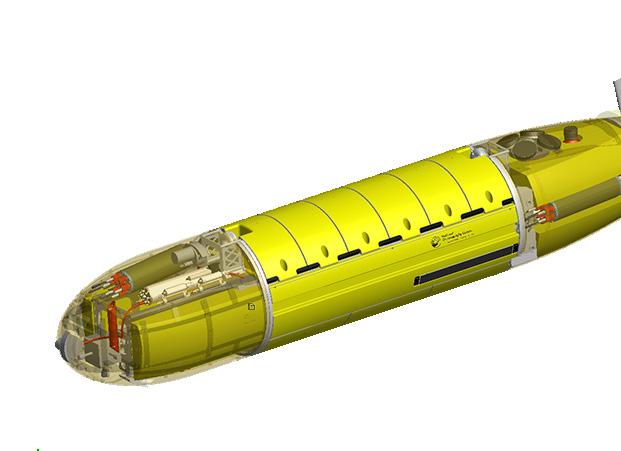
"If, for example, the front half of the vehicle is damaged and the obstacle avoidance were to stop working, the vehicle would stop doing near-ice operations and fall back on using the upwards and downwards facing ADCP’s to prevent crashing into the ice or seabed.
If there was damage to the rear, however and the ADCP’s were to stop working, the forward-facing obstacle avoidance system has a wide enough range that it can see the ice above and the seabed below to prevent collisions.
Similarly if the primary navigation, which is positioned in the back of the submarine, were to be affected there is both a depth sensor in the CTD and a spare gyro in the front that can be used for navigation. For the propulsion, it would be possible to lose one of the dual thrusters along with an actuator and it would still return due to the control algorithms and the cross-form actuator arrangement. The AUV has a cruise speed of 1.2-1.4m/s with a navigation accuracy of 0.01% or less than 0.1m per kilometre.

Power technology is another area that has changed radically in the past decade. In order to achieve a 400km range, the original Autosub 3 was powered by 5000 non-rechargeable alkaline D-Cells. The power system on the AKUI, however, is based on using a new NOC designed pressure tolerant rechargeable lithium iron battery. Edgetech 2205 sidescan

Each battery unit has a 4 x 1.25kW hr sub modules, giving a total of 5 kW hrs per battery with a maximum 30A discharge. The entire AUV has 12 such batteries giving a total output of ~58kW hrs at 0�. The batteries only weigh 8kg each in water and can be located in one area or be distributed more around the vehicle.
The communications satellite, GPS and Wi-Fi systems are also dual redundant. There is an acoustic control beacon along with a back-up standalone acoustic beacon, light flashes and Iridium beacons. "We would also like to include an AIS (Automatic Identification system) that identifies itself to local shipping to prevent collisions and help recovery, but nobody makes one rated to 6000m
Launch and recovery is another area in which requires specialist equipment.
"There are many ways of retrieving an AUV. One common way is for the AUV nose to be jettisoned and capturing the cord between the nose and the rest of the AUV with some sort of hook mechanism,” said Kingsland. “This is connected to a winch, allowing the AUV to be pulled up a ramp.
“Although this recovery system makes for a lighter submarine structure allowing for greater payload capacity it is not an ideal recovery system in high sea states. This is because mating a solid submarine and solid recovery ramp both going in two different directions due to wave action is tricky. Instead, the NOC developed a system in which the AUV is attached to a pair of lifting points and the AUV recovered away from the ship, by a custom crane.
Following in water trials winter 2020, the sensor commissioning and deepwater trials will follow in Spring/ Summer 2021 with Under Ice trials later that year.
AUTOMATED SAMPLE TAKING
The hybrid ROV Nereid Under Ice (NUI) has taken the first known automated sample performed by a robotic arm in the ocean. This was part of a project undertaken by an international team of researchers exploring the chemical-laden environment of Kolumbo Kolumbo volcano, an active submarine volcano off Greece’s Santorini island.
To do this, NUI was equipped with Artificial Intelligence (AI)-based automated planning software—including a planner named ‘Spock’—that enabled the ROV to decide which sites to visit in the volcano and take samples autonomously.
The NUI hybrid ROV was built by Woods Hole Oceanographic Institution (WHOI) in 2014 to carry out deepwater oceanography. While most ROVs are deigned to move a few hundred feet laterally, the NUI is designed to travel laterally up to 40km ( 25 miles). while still receiving control signals and transmitting data.
The NUI ROV incorporates its own battery system whcih means the thether can be reduced to a single fibre optic line, for sending high-definition video, back to the mother ship. In addition, it also carries a full suite of acoustic, chemical, and biological sensors for investigating the underwater environment, as well as a seven-function electro-hydraulic manipulator arm. The vehicle is rated to dive 2000m (6500ft) beneath the surface to sample or survey the mid-water or sea floor
Gathering a sample without a pilot driving the vessel was a huge step forward,” said Rich Camilli, an associate scientist at WHOI leading the development of automation technology as part of NASA’s Planetary Science and Technology from Analog Research (PSTAR) interdisciplinary research programme. "The scientists say that handing over the controls to ocean robots will allow them to explore without human intervention."
Issuing a issued a command to the autonomous manipulator resulted in a slurp-sample hose attached to the robotic arm extending down to the precise sample location and sucking up the dirt.
"This level of automation will be important for NASA as they look toward developing technologies to explore ocean worlds beyond our solar system.without the assistance of a pilot,” he said. "Moving forward, the work will include training ocean robots to see like ROV pilots using 'gaze tracking' technology, and building a robust humanlanguage interface so scientists can talk directly to robots without a pilot go-between.
“We can eventually see having a network of cognitive ocean robots where there’s a shared intelligence spanning an entire fleet, with each vehicle working cooperatively like bees in a hive,” Camilli said. “It will go well beyond losing the joystick."
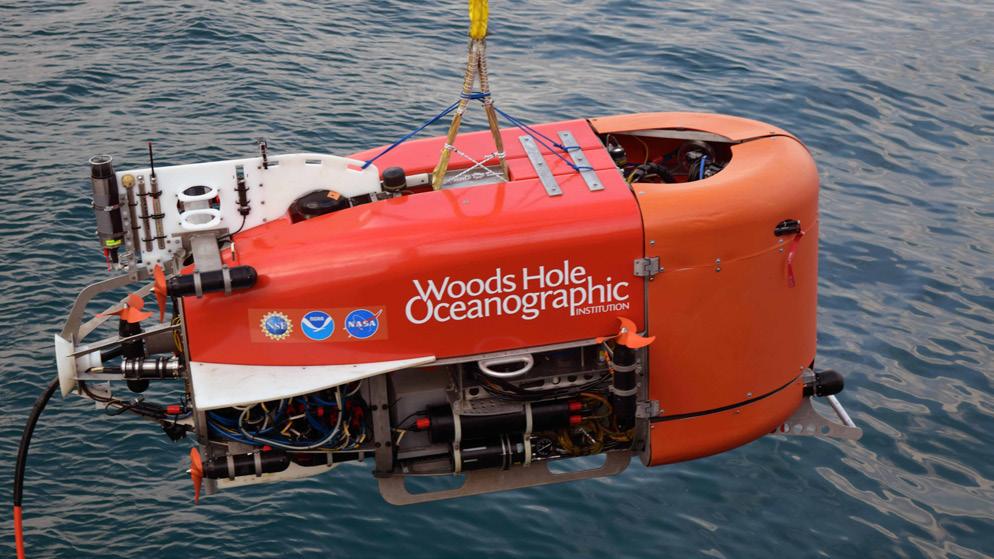
Nereid Under Ice (NUI)
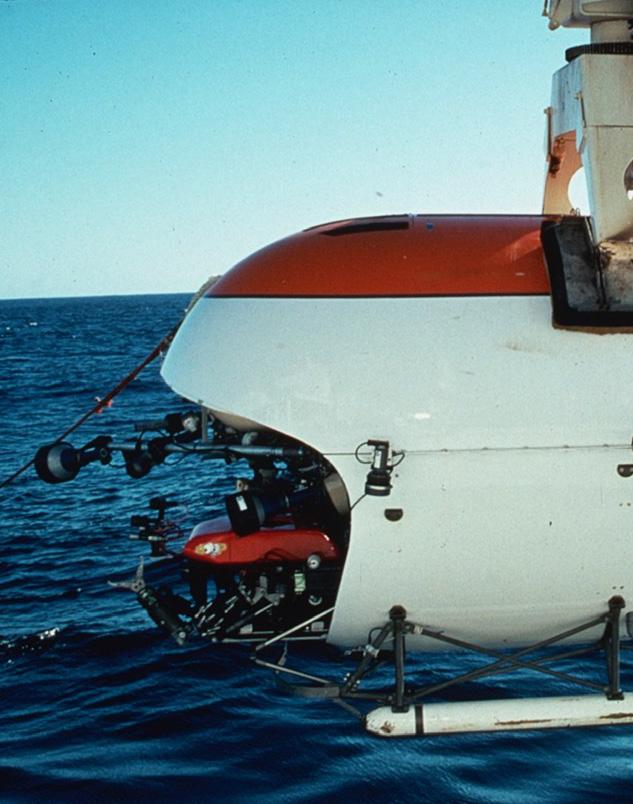
The MIRS sub with a small ROV on the bow MIR-2

MORECAMBE BAY 1989

We have had a few of Morecambe Bay before, but this shows the slant rig better.

Morecambe had a very shallow reservoir. In these days before slant drilling. British Gas had the idea of inclining the actual derrick which enabled drilling into the reservoir at an angle.
A few months ago, Spirit Energy was granted approval to decommission the DP3 and DP4installations which will be removed by a heavy lift vessel and returned to shore.
EIDER Loading the jacket on the barge
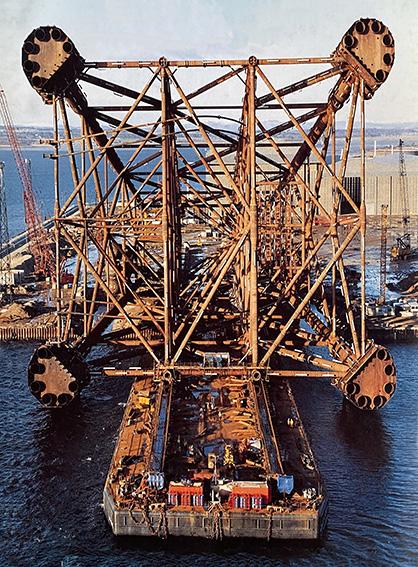
Yes, we've had images of this before.
The jacket was installed in 1988 using a self-upending technique. Rather than using hydraulic valves to actively control the ballasting after the jacket had skidded off, the legs were free flooded with water entering from basal holes. The elimination of auxiliary buoyancy saved around 1000t in weight.
Eider was bought by Taqa and production ceased in 2018. It is now used to support the Otter field.
I wanted to get basic specs such as water depth etc, (157m) and googled 'Shell, Eider, Jacket'. Up came a load of fleeces and mountaineering coats!!

